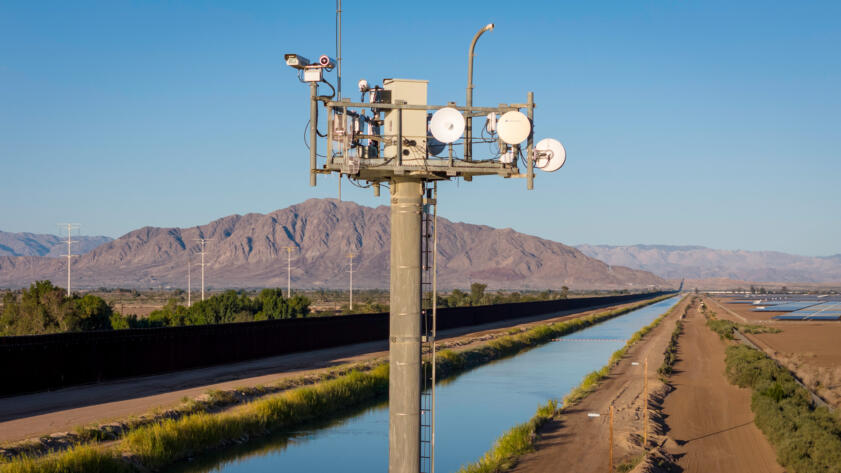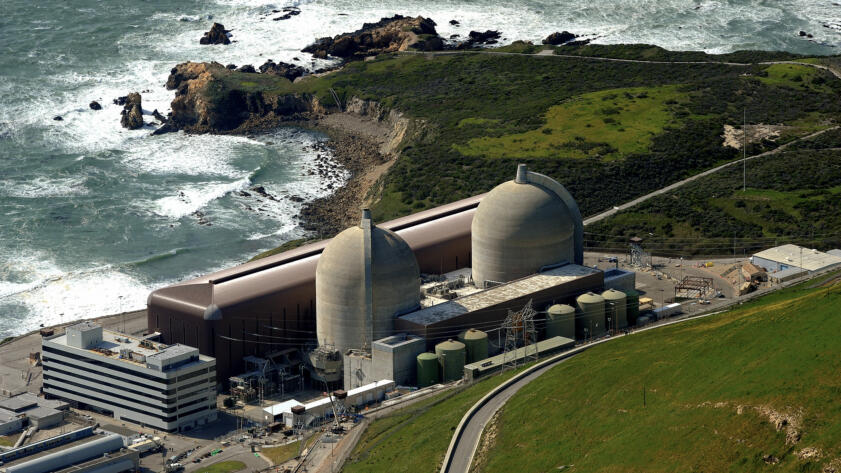The Markup, now a part of CalMatters, uses investigative reporting, data analysis, and software engineering to challenge technology to serve the public good. Sign up for Klaxon, a newsletter that delivers our stories and tools directly to your inbox.
Diablo Canyon, California’s sole remaining nuclear power plant, has been left for dead on more than a few occasions over the last decade or so, and is currently slated to begin a lengthy decommissioning process in 2029. Despite its tenuous existence, the San Luis Obispo power plant received some serious computing hardware at the end of last year: eight NVIDIA H100s, which are among the world’s mightiest graphical processors. Their purpose is to power a brand-new artificial intelligence tool designed for the nuclear energy industry.
Pacific Gas and Electric, which runs Diablo Canyon, announced a deal with artificial intelligence startup Atomic Canyon—a company also based in San Luis Obispo—around the same time, heralding it in a press release as “the first on-site generative AI deployment at a U.S. nuclear power plant.”
For now, the artificial intelligence tool named Neutron Enterprise is just meant to help workers at the plant navigate extensive technical reports and regulations — millions of pages of intricate documents from the Nuclear Regulatory Commission that go back decades — while they operate and maintain the facility. But Neutron Enterprise’s very existence opens the door to further use of AI at Diablo Canyon or other facilities — a possibility that has some lawmakers and AI experts calling for more guardrails.
PG&E is deploying the document retrieval service in stages. The installation of the NVIDIA chips was one of the first phases of the partnership between PG&E and Atomic Canyon; PG&E is forecasting a “full deployment” at Diablo Canyon by the third quarter of this year, said Maureen Zawalick, the company’s vice president of business and technical services. At that point, Neutron Enterprise—which Zawalick likens to a data-mining “copilot,” though explicitly not a “decision-maker”—will be expanded to search for and summarize Diablo Canyon-specific instructions and reports too.
“We probably spend about 15,000 hours a year searching through our multiple databases and records and procedures,” Zawalick said. “And that’s going to shrink that time way down.”
Trey Lauderdale, the chief executive and co-founder of Atomic Canyon, told CalMatters his aim for Neutron Enterprise is simple and low-stakes: he wants Diablo Canyon employees to be able to look up pertinent information more efficiently. “You can put this on the record: the AI guy in nuclear says there is no way in hell I want AI running my nuclear power plant right now,” Lauderdale said.
We probably spend about 15,000 hours a year searching through our multiple databases.
Maureen Zawalick, Pacific Gas & Electric VP of Business and Technical Services
That “right now” qualifier is key, though. PG&E and Atomic Canyon are on the same page about sticking to limited AI uses for the foreseeable future, but they aren’t foreclosing the possibility of eventually increasing AI’s presence at the plant in yet-to-be-determined ways. According to Lauderdale, his company is also in talks with other nuclear facilities, as well as groups who are interested in building out small modular reactor facilities, about how to integrate his startup’s technology. And he’s not the only entrepreneur eyeing ways to introduce artificial intelligence into the nuclear energy field.
In the meantime, questions remain about whether sufficient safeguards exist to regulate the combination of two technologies that each have potential for harm. The Nuclear Regulatory Commission was exploring the issue of AI in nuclear plants for a few years, but it’s unclear if that will remain a priority under the Trump administration. Days into his current term, Trump revoked a Biden administration executive order that set out AI regulatory goals, writing that they acted “as barriers to American AI innovation.” For now, Atomic Canyon is voluntarily keeping the Nuclear Regulatory Commission abreast of its plans.
Tamara Kneese, the director of tech policy nonprofit Data & Society’s Climate, Technology, and Justice program, conceded that for a narrowly designed document retrieval service, “AI can be helpful in terms of efficiency.” But she cautioned, “The idea that you could just use generative AI for one specific kind of task at the nuclear power plant and then call it a day, I don’t really trust that it would stop there. And trusting PG&E to safely use generative AI in a nuclear setting is something that is deserving of more scrutiny.”
For those reasons, Democratic Assemblymember Dawn Addis—who represents San Luis Obispo—isn’t enthused about the latest developments at Diablo Canyon. “I have many unanswered questions of the safety, oversight, and job implications for using AI at Diablo,” Addis said. “Previously, I have supported measures to regulate AI and prevent the replacement and automation of jobs. We need those guardrails in place, especially if we are to use them at highly sensitive sites like Diablo Canyon.”
How AI Came to SLO
Before Lauderdale moved into artificial intelligence and nuclear energy, he founded a health care software company called Voalte, which was designed to help hospital staff communicate over iPhones, reducing their reliance on loudspeaker paging and desktop computer systems. At the time, circa 2008, Lauderdale said his pitch was met with worries and resistance from hospital staff. He likes to draw parallels between that experience, which culminated in 2019 when he sold his company to a hospital bed manufacturer for $180 million, and the pushback he’s heard about Atomic Canyon.
In 2021, Lauderdale moved to San Luis Obispo so he, his wife, and kids could be closer to his wife’s family in Northern California. Lauderdale told CalMatters he didn’t realize how close Diablo Canyon was to his new home until after he relocated. It was through meeting Diablo Canyon workers out in the community, he says, that he learned more about nuclear energy and landed on his next startup idea.

Artificial Intelligence
Trump Wants Even Looser AI Guardrails. Why California, Despite Passing Over 20 AI Bills This Year, Might Not Push Back
President-elect Trump has vowed to rescind an executive order that imposed AI safeguards, and could use tech to enable mass deportations. How far will California go in the other direction?
Atomic Canyon launched in 2023 with a task of downloading roughly 53 million pages of publicly available Nuclear Regulatory Commission documents, which encapsulate all of America’s nuclear energy fleet and are available on a database called ADAMS. That process started around January 2024, after Lauderdale gave the Nuclear Regulatory Commission a heads-up about what Atomic Canyon was planning to do: “I reached out to [the commission] just to say, hey, I’m Trey Lauderdale, American citizen, entrepreneur. We’re going to start building AI in the nuclear space, and we just wanted to make sure the NRC was aware that when they see all these downloads, it’s not a foreign actor or someone trying to do anything bad to their system.”
Lauderdale said the commission supported Atomic Canyon’s efforts. After downloading the data, Atomic Canyon partnered with the Department of Energy’s Oak Ridge National Laboratory in Tennessee to kick off research and development. The lab houses the Frontier supercomputer, which was the world’s fastest when it debuted two years ago. Atomic Canyon used Frontier to build a form of AI that can perform “sentence-embedding models,” which Lauderdale says are capable of processing nuclear jargon and are less likely to “hallucinate,”or answer a question using fabrications.
“You basically teach the artificial intelligence how to understand nuclear words, their context, what different acronyms mean,” he said.
In the spring of 2024, Lauderdale and PG&E representatives kicked off formal discussions about how Atomic Canyon could be of use at Diablo Canyon. PG&E soon invited Atomic Canyon staff to visit the nuclear facility, where they shadowed employees for a few weeks, “observing where there were operational inefficiencies that we could try to target with AI,” Lauderdale said.
Then, in September 2024, Atomic Canyon announced the completion of testing on its AI, referred to as “FERMI”; these models, which are open-source, are what collectively make up the Neutron Enterprise software. A few months later, in November, came the first-of-its-kind announcement with PG&E.
How Neutron Enterprise Works
PG&E brought in NVIDIA hardware to Diablo Canyon to run FERMI. Zawalick and Lauderdale both told CalMatters that the Neutron Enterprise software is being installed without cloud access so that sensitive, internal, documents don’t leave the site. Zawalick said their data storage policies meet all Nuclear Regulatory Commission and Department of Energy nuclear information requirements, and will be continuously tested and inspected.
Initial Neutron Enterprise users are currently only using the software to search through publicly available regulatory data. PG&E and Atomic Canyon hope to initiate the next phase of Neutron Enterprise’s rollout in the third quarter of 2025, when more on-site employees will be able to use the service, and it will be able to search for and summarize internal documents by utilizing optical character recognition (which allows more documents to be indexed), and retrieval-augmented generation (which allows more flexible querying).
According to Lauderdale, the use of artificial intelligence to speed up document searches isn’t risky. If AI fails to find the information sought by a worker, the person can “just fall back to the previous way they would search,” he said, referring to sifting through multiple on-site databases and sometimes manually pulling paper files.

Artificial Intelligence
Everyone Is Judging AI by These Tests. But Experts Say They’re Close to Meaningless
Benchmarks used to rank AI models are several years old, often sourced from amateur websites, and, experts worry, lending automated systems a dubious sense of authority
Neutron Enterprise also generates short summarizations of documents while users are searching databases, and it’s possible those summarizations could produce incorrect information, too — but they would not alter the actual contents/instructions contained within the documents that are read over by workers.
CalMatters asked a number of state lawmakers — especially those near Diablo Canyon — what they think of Atomic Canyon’s first-of-its-kind partnership with PG&E. The consensus response was positive, though tailored to Neutron Enterprise’s currently limited functionality.
Malibu Democratic Sen. Henry Stern, a member of the Senate Energy Committee, told CalMatters he’s “reticent to rain on AI tools that can do better grid management,” so long as proper safety protocols are followed. Democratic Sen. John Laird, who represents San Luis Obispo, took an even-keel stance: “As AI integration expands, so does its energy demand… Balancing technological advancement with public safety, environmental stewardship, and regulatory oversight will be critical in shaping AI’s role in our state’s energy future,” he said. San Francisco Sen. Scott Wiener, whose ambitious AI safety legislation was vetoed by the governor last year, agrees with his Democratic colleagues: “If AI can help improve the day-to-day efficiencies of Diablo Canyon, that’s great.”
Out of five San Luis Obispo County Board of Supervisors, three responded to requests for comment. Supervisor Bruce Gibson said that “using AI to access and organize required information in this situation makes sense,” but he stressed the need for transparency and public updates from PG&E. Supervisor Heather Moreno said that it’s a good thing PG&E will be taking “advantage of a ‘supercharged’ search engine… As it will not be used for operations, this appears to be a good first step in using AI at Diablo Canyon.” And Supervisor Dawn Ortiz-Legg, a former PG&E employee, said she was “encouraged” that Diablo Canyon was working with Atomic Canyon “to navigate the enormous amounts of data collected from thousands of pages of audits and reports.”
Varying Rules and Regulations
However innocuous the use of AI at Diablo Canyon today, there are big-picture concerns about how the technology could later be used there and at other facilities. “I think we have to be really careful when we talk about broader AI decision-making,” Wiener said. “That’s why it’s really, really important to beef up government capacity to set standards around use of AI in sensitive contexts such as a nuclear power plant.”
It’s really, really important to beef up government capacity to set standards around use of AI in sensitive contexts such as a nuclear power plant.
Scott Wiener, Democratic Assemblymember from San Francisco
In November 2024, Nuclear Regulatory Commission Inspector General Robert J. Feitel came to the same conclusion. He identified “planning for and assessing the impact of Artificial Intelligence and Machine Learning on nuclear safety and security” as one of the nine major challenges the agency faced. The month prior, a commission-sponsored report by the Southwest Research Institute looked into artificial intelligence-related “regulatory gaps” in the nuclear energy industry. It found fewer than 100 gaps, but also noted that “no practical AI standards were identified” from outside sources that could help address those gaps. The report recommended developing a number of AI-specific guides.
Atomic Canyon and PG&E appear to be keeping the Nuclear Regulatory Commission in the loop on their own accord. “I wouldn’t claim we have an official relationship with the NRC, but we make sure to brief them on what we’re doing, because, being newer in the nuclear industry, surprises are bad,” Lauderdale said. He believes that the nuclear energy industry’s cautious approach will, in itself, act as a “natural buffer” against overly invasive or dangerous AI integrations, though he conceded that “as we start to traverse into applications that do introduce risk, we absolutely will want guardrails and regulation to make sure that AI is properly deployed.”
When CalMatters first spoke with PG&E’s Zawalick in December, she mentioned she’d just recently met with the Nuclear Regulatory Commission’s AI working group, an advisory committee of sorts. Since then, she hasn’t had further discussions with the commission about AI regulations, she recently told CalMatters.
And the Diablo Canyon Independent Safety Committee, a state-appointed safety group that inspects the nuclear facility and provides recommendations about its operations, first learned about PG&E’s deal with Atomic Canyon through media reports, the committee’s legal counsel Bob Rathie told CalMatters. In December 2024 and January 2025, a committee representative participated in two fact-finding visits about Neutron Enterprise, meeting with PG&E workers to learn more about the software. The committee concluded from those visits that Diablo Canyon’s use of artificial intelligence is “positive,” and they have no safety concerns at this time.
What Happens Next?
Lauderdale spoke to CalMatters while traveling to another nuclear facility, though he couldn’t reveal which one. He said that Atomic Canyon is “in discussions” with “many other nuclear organizations,” and that some “really exciting announcements” will come later this year. Through Atomic Canyon’s partnership with Diablo Canyon, he wants to demonstrate a proof of concept for existing nuclear facilities, as well as companies interested in building or re-commissioning nuclear facilities. He hopes Diablo Canyon’s lifecycle is expanded beyond the current decommissioning timeline, but if it’s not, his software can be used for the facility’s decommissioning process, he said.
“As we gain more trust in the product and build out more capabilities, we will pick other non-risky activities that will take off one-by-one, and we’ll keep creating more value with this new technology,” he said.
Responding to questions about whether the rollout of AI at Diablo Canyon has had sufficient oversight, Lauderdale reiterated that his startup product does not have a significant operational role.
“I consider our company the leader in deploying AI and nuclear,” he said, before giving a future-facing assessment that left the door just slightly ajar: “and I think we will not have AI running nuclear power plants for a very long time.”





